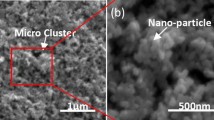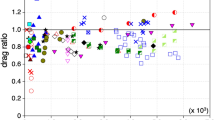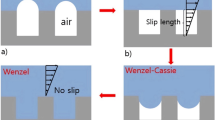Abstract
This paper proposes a novel bubble model to analyze drag reduction. The relationship between the slip length and air bubble height is discussed. The numerical relationship between the surface contact angle and slip length is obtained using the solid-liquid contact ratio in the Cassie equation. The surface drag reduction ratio increases by 40% at low velocities when the solid liquid contact ratio decreases from 90% to 10%. An experimental setup to study liquid/solid friction drag is reported. The drag reduction ratio for the superhydrophobic surface tested experimentally is 30%–35% at low velocities. These results are similar to the simulation results obtained at low velocities.
Similar content being viewed by others
References
Y. L. Zhang, H. Xia, E. Kim, and H. B. Sun, Recent developments in superhydrophobic surfaces with unique structural and functional properties, Soft Matter 8(44), 11217 (2012)
C. H. Xue, S. T. Jia, J. Zhang, and J. Z. Ma, Large-area fabrication of superhydrophobic surfaces for practical applications: An overview, Sci. Technol. Adv. Mater. 11(3), 033002 (2010)
G. McHale, M. Newton, and N. Shirtcliffe, Immersed superhydrophobic surfaces: Gas exchange, slip and drag reduction properties, Soft Matter 6(4), 714 (2010)
Y. Zhao, Y. Song, W. Song, W. Liang, X. Jiang, Z. Tang, H. X. Xu, Z. X. Wei, Y. Q. Liu, M. H. Liu, L. Jiang, X. H. Bao, L. J. Wan, and C. L. Bai, Progress of nanoscience in China, Front. Phys. 9(3), 257 (2014)
N. P. Dasgupta and P. Yang, Semiconductor nanowires for photovoltaic andphotoelectrochemical energy conversion, Front. Phys. 9(3), 289 (2014)
P. Tao, W. Shang, C. Song, Q. Shen, F. Zhang, Z. Luo, N. Yi, D. Zhang, and T. Deng, Bioinspired engineering of thermal materials, Adv. Mater. 27(3), 428 (2015)
J. Wang, M. Liu, R. Ma, Q. Wang, and L. Jiang, In situ wetting state transition on micro- and nanostructured surfaces at high temperature, ACS Appl. Mater. Interfaces 6(17), 15198 (2014)
U. G. K. Wegst, H. Bai, E. Saiz, A. P. Tomsia, and R. O. Ritchie, Bioinspired structural materials, Nat. Mater. 14(1), 23 (2014)
W. Barthlott, T. Schimmel, S. Wiersch, K. Koch, M. Brede, M. Barczewski, S. Walheim, A. Weis, A. Kaltenmaier, A. Leder, and H. F. Bohn, The Salvinia paradox: Superhydrophobic surfaces with hydrophilic pins for air retention under water, Adv. Mater. 22(21), 2325 (2010)
S. Lyu, D. C. Nguyen, D. Kim, W. Hwang, and B. Yoon, Experimental drag reduction study of super-hydrophobic surface with dual-scale structures, Appl. Surf. Sci. 286, 206 (2013)
J. Cui, W. Li, and W. Lam, Numerical investigation on drag reduction with superhydrophobic surfaces by lattice- Boltzmann method, Comput. Math. Appl. 61(12), 3678 (2011)
Y. Gan, A. Xu, G. Zhang, and Y. Li, Physical modeling of multiphase flow via lattice Boltzmann method: Numerical effects, equation of state and boundary conditions, Front. Phys. 7(4), 481 (2012)
K. Fukagata, N. Kasagi, and P. Koumoutsakos, A theoretical prediction of friction drag reduction in turbulent flow by superhydrophobic surfaces, Phys. Fluids 18(5), 051703 (2006)
E. Lauga and H. A. Stone, Effective slip in pressure-driven Stokes flow, J. Fluid Mech. 489, 55 (2003)
J. Davies, D. Maynes, B. W. Webb, and B. Woolford, Laminar flow in a microchannel with superhydrophobic walls exhibiting transverse ribs, Phys. Fluids 18(8), 087110 (2006)
Y. P. Cheng, C. J. Teo, and B. C. Khoo, Microchannel flows with superhydrophobic surfaces: Effects of Reynolds number and pattern width to channel height ratio, Phys. Fluids 21(12), 122004 (2009)
J. Yang, J. Duan, D. Fornasiero, and J. Ralston, Very small bubble formation at the solid-water interface, J. Phys. Chem. B 107(25), 6139 (2003)
J. Wang, H. Chen, T. Sui, A. Li, and D. Chen, Investigation on hydrophobicity of lotus leaf: Experiment and theory, Plant Sci. 176(5), 687 (2009)
S. R. German, X.Wu, H. An, V. S. J. Craig, T. L. Mega, and X. Zhang, Interfacial nanobubbles are leaky: Permeability of the gas/water interface, ACS Nano 8(6), 6193 (2014)
X. Zhang, A. Quinn, and W. A. Ducker, Nanobubbles at the interface between water and a hydrophobic solid, Langmuir 24(9), 4756 (2008)
J. Wang, B.Wang, and D. Chen, Underwater drag reduction by gas, Friction 2(4), 295 (2014)
K. Mohanarangam, S. C. P. Cheung, J. Y. Tu, and L. Chen, Numerical simulation of micro-bubble drag reduction using population balance model, Ocean Eng. 36(11), 863 (2009)
P. P. Modi and S. Jayanti, Pressure losses and flow maldistribution in ducts with sharp bends, Chem. Eng. Res. Des. 82(3), 321 (2004)
B. M. Borkent, S. M. Dammer, H. Schonherr, G. J. Vancso, and D. Lohse, Superstability of surface nanobubbles, Phys. Rev. Lett. 98(20), 204502 (2007)
P. Joseph, C. Cottin-Bizonne, J. M. Benoit, C. Ybert, C. Journet, P. Tabeling, and L. Bocquet, Slippage of water past superhydrophobic carbon nanotube forests in microchannels, Phys. Rev. Lett. 97(15), 156104 (2006)
A. Steinberger, C. Cottin-Bizonne, P. Kleimann, and E. Charlaix, High friction on a bubble mattress, Nat. Mater. 6(9), 665 (2007)
C. Lee and C. J. Kim, Maximizing the giant liquid slip on superhydrophobic microstructures by nanostructuring their sidewalls, Langmuir 25(21), 12812 (2009)
J. Hyväluoma and J. Harting, Slip flow over structured surfaces with entrapped microbubbles, Phys. Rev. Lett. 100(24), 246001 (2008)
S. Richardson, No-slip boundary condition, J. Fluid Mech. 59(04), 707 (1973)
K. M. Jansons, Determination of the macroscopic (partial) slip boundary condition for a viscous flow over a randomly rough surface with a perfect slip microscopic boundary condition, Phys. Fluids 31(1), 15 (1988)
Y. Wang, X. W. Liu, H. F. Zhang, and Z. P. Zhou, Superhydrophobic surfaces created by a one-step solution-immersion process and their drag-reduction effect on water, RSC Advances 5(24), 18909 (2015)
Author information
Authors and Affiliations
Corresponding author
Rights and permissions
About this article
Cite this article
Yin, L., Zhang, HF., Shi, SY. et al. Numerical investigation of relationship between water contact angle and drag reduction ratio of superhydrophobic surfaces. Front. Phys. 11, 114701 (2016). https://doi.org/10.1007/s11467-015-0546-1
Received:
Accepted:
Published:
DOI: https://doi.org/10.1007/s11467-015-0546-1




